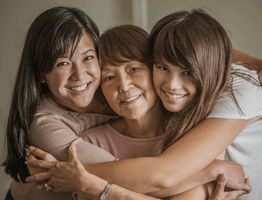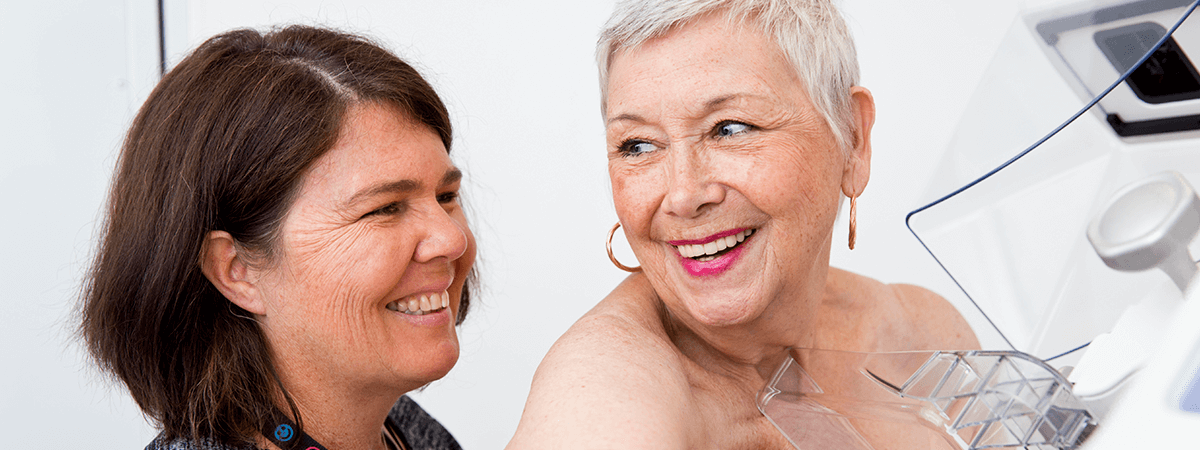Why is breast screening important?
A breast screen can find very small cancers – the size of a grain of rice – before they can be felt or noticed by you or your doctor.3 Finding breast cancer early means a better chance of survival.4
If breast cancer is found early through BreastScreen NSW, it's likely to be small and successfully treated. It's also less likely that you will need a mastectomy.5
What is BreastScreen NSW?
BreastScreen NSW aims to help women aged 50–74 detect breast cancer early by providing free breast screens to women at over 250 locations across NSW.
What have we achieved?
For women aged 50–74, the breast cancer death rate has decreased by almost half (45%) since the BreastScreen Australia Program began in 1991.6
Australia now has one of the best breast cancer survival rates in the world – 93% after 5 years for women aged 50-74.7
However, 50% of women aged 50 – 74 in NSW are still not being screened.
What you need to know
A breast screen is the best method to detect breast cancer early for women over the age of 50.8
Women aged 50-74 are invited by BreastScreen NSW to have a breast screen every two years. Aboriginal and Torres Strait Islander women are recommended to screen from 40 years.9
Women aged 75+ are recommended to talk to their GP to find out if breast screening is right for them.
Visit the BreastScreen NSW website to find your nearest service and book online, or call us on 13 20 50.
In this section

Find out why it's important for women to have a regular mammogram and how breast screening can help to reduce the impact of breast cancer.

Who should be screened for breast cancer? Find out the age ranges where mammograms are most important.

‘Breast Health and Screening’ Flipcharts & Facilitator Manuals provide education on breast cancer and screening to people from different cultural backgrounds.

BreastScreen NSW provides free breast screening (mammograms) to women in NSW. Screening is available in over 250 locations across the state.
2. www.canceraustralia.gov.au/resources/position-statements/early-detection-breast-cancer
4. Australian Institute of Health and Welfare 2021. BreastScreen Australia monitoring report 2021. Cat. no. CAN 140. Canberra: AIHW. p 4
5. Shahabi-Kargar Z, Johnston A, Warner-Smith M, Creighton N, Roder D. Differences in breast cancer treatment pathways for women participating in screening through Breastscreen New South Wales (BSNSW). AMJ 2020; 13(6):189–200.
6. Australian Institute of Health and Welfare. (2021). BreastScreen Australia monitoring report 2021, p. 82. Cat. no. CAN 140. Canberra: AIHW. Retrieved from: https://www.aihw.gov.au/reports/cancer-screening/breastscreen-australia-monitoring-report-2021/report-editions
7. Australian Institute of Health and Welfare. (2021). BreastScreen Australia monitoring report 2021, p. 82. Cat. no. CAN 140. Canberra: AIHW. Retrieved from: https://www.aihw.gov.au/reports/cancer-screening/breastscreen-australia-monitoring-report-2021/report-editions
8. www.canceraustralia.gov.au/resources/position-statements/early-detection-breast-cancer
9. Evidence shows that Aboriginal women in NSW with breast cancer were younger and more likely to have more advanced cancer at diagnosis than non-Aboriginal women:
Moore SP, Soerjomataram I, Green AC, Garvey G, Martin J, Valery PC. Breast cancer diagnosis, patterns of care and burden of disease in Queensland, Australia (1998-2004): does being Indigenous make a difference? Int J Public Health. 2016;61(4):435-42.
Banham D, Roder D, Keefe D, Farshid G, Eckert M, Howard N, et al. Disparities in breast screening, stage at diagnosis, cancer treatment and the subsequent risk of cancer death: a retrospective, matched cohort of aboriginal and non-aboriginal women with breast cancer. BMC Health Serv Res. 2019;19(1):387.
Tapia KA, Garvey G, McEntee MF, Rickard M, Lydiard L, Brennan PC. Breast screening attendance of Aboriginal and Torres Strait Islander women in the Northern Territory of Australia. Australian and New Zealand Journal of Public Health. 2019;43(4):334-39

